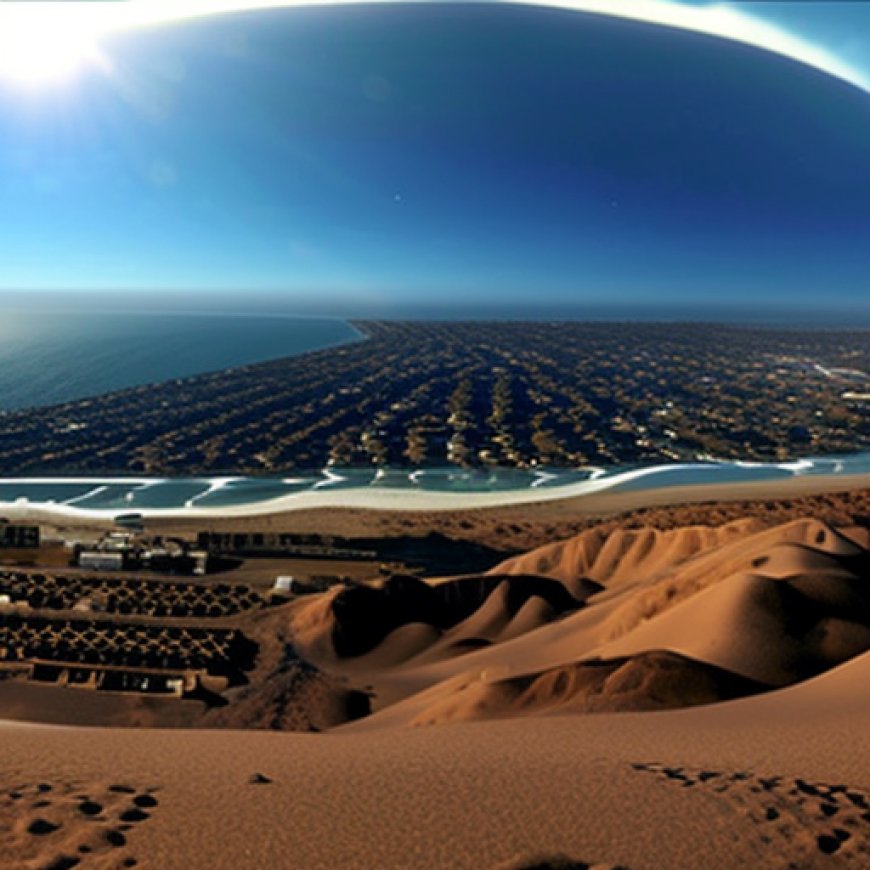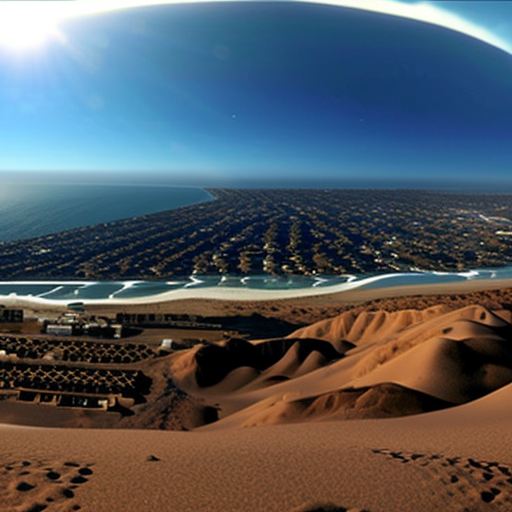Preserving Coastal Habitats: Santa Monica undergoes second dune restoration project
Preserving Coastal Habitats: Santa Monica undergoes second dune restoration project Argonaut Online


Dune Restoration Project in Santa Monica
Santa Monica is moving forward on its second dune restoration project. Coordinated by The Bay Foundation, adjustments made to the city’s beach maintenance regimen will allow for the restoration of natural habitats.
Background
For decades, Santa Monica’s shores have been cleaned with tractors that raked the sand flat for beachgoers. Raking beaches can disrupt the natural balance of sand retention and the development of ecosystems.
With the increase in storms in Southern California, the current state of local beaches makes them vulnerable to withstand sea level rise, explained Alexandria Tower, the director of the Coastal Adaptation Program at The Bay Foundation.
The Project
The dune restoration project will undo that damage by roping off four polygons totaling five acres and introducing native dune vegetation as seeds and juvenile plants.
The Bay Foundation team collected seeds locally from the Santa Monica Bay coastal region for the restoration project, including vegetation like beach burr, beach saltbush, beach evening primrose and red sand verbena.
“We’re going to make it prettier. We’re going to install native plants for greater biodiversity, to protect shorebirds like the Snowy Plover,” Tower said.
Efforts began on March 14 in front of the Annenberg Community Beach House — extending the unique ecosystem even further in the Los Angeles region.
The second dune restoration location is roughly a quarter-mile south of the first restoration from 2015, which spans three acres, hosting dunes that are about 4 feet tall.
Importance of Beach Ecosystems
Tower emphasized that beach ecosystems, including dunes and vegetation, play crucial roles in stabilizing sand and preventing erosion.
“As the water gets higher and higher here, the dunes are going to be helpful in creating a buffer between the ocean and these houses and that cliff,” Tower said. “The idea is that with this soft nature-based kind of defense, we don’t see as much erosion.”
She went on to explain that man-made barriers actually exacerbate the issue.
“When we build armoring, some sort of hard scape, like a wall or riprap, it actually enhances the scouring of the sand and pulls sand away,” Tower said.
Sustainable Development Goals
Karina Johnston, a senior restoration ecologist and a researcher of the pilot project, hopes that dune restoration is considered one solution for adaptation to sea level rise.
“I think there’s a lot of opportunity for it in Los Angeles and up and down the Southern California coastline,” Johnston said.
She described a cycle in this habitat, scientifically known as a feedback loop, wherein coastal strand vegetation accumulates sand, forming dunes beneath and supporting the growth of more vegetation.
In addition to slowing erosion, as Tower mentioned, Johnston cited other environmental benefits including carbon sequestration, water filtration, flood protection, habitat for species and overall improved biodiversity.
Community Engagement
The dune habitat not only enhances the aesthetic appeal, Johnston continued, but benefits the community interest for recreational dune observing.
“Certainly we want to be able to go and enjoy the beach, play sports and take our kids in, and I think that it’s really important to consider a balance between recreation and these benefits that we’re looking for,” Johnston said.
A follower of The Bay foundation, Laurene Von Klan, was very excited about the second restoration project — adding that she was drawn to Santa Monica because of its environmental recreation opportunities.
“Looking at things and getting to learn what lives here and what we share the planet with is part of being in Santa Monica. It’s part of the experience,” said Von Klan.
Nico Predock, the sustainability analyst for the city of Santa Monica, also connected emotionally to this restoration as he grew up surfing these beaches.
“It just makes me happy to see these types of projects go up and see the native habitat come back and offer all these benefits,” Predock said.
He noted that the dunes will also be accessible to the public as requested by the California Coastal Commission.
Impact and Future Opportunities
“(The city of Santa Monica) was really excited to have a demonstration project on its beach and be able to use it as an opportunity to engage the community and to talk to the community about coastal resilience and protection from flooding and sea level rise,” Johnston said.
She added that the project can also serve as an example to other local and state municipalities considering what types of measures they can implement to help protect their coastlines.
“Climate change impacts, like sea level rise and flooding, can be scary,” Johnston said. “So knowing that there are opportunities for these types of solutions is really exciting.”
SDGs, Targets, and Indicators
-
SDG 14: Life Below Water
- Target 14.2: By 2020, sustainably manage and protect marine and coastal ecosystems to avoid significant adverse impacts, including by strengthening their resilience, and take action for their restoration, to achieve healthy and productive oceans.
- Indicator 14.2.1: Proportion of national exclusive economic zones managed using ecosystem-based approaches.
-
SDG 15: Life on Land
- Target 15.1: By 2020, ensure the conservation, restoration, and sustainable use of terrestrial and inland freshwater ecosystems and their services, in particular forests, wetlands, mountains, and drylands, in line with obligations under international agreements.
- Indicator 15.1.1: Forest area as a proportion of total land area.
- Indicator 15.1.2: Proportion of important sites for terrestrial and freshwater biodiversity that are covered by protected areas.
-
SDG 11: Sustainable Cities and Communities
- Target 11.5: By 2030, significantly reduce the number of deaths and the number of people affected and substantially decrease the direct economic losses relative to global gross domestic product caused by disasters, including water-related disasters, with a focus on protecting the poor and people in vulnerable situations.
- Indicator 11.5.1: Number of deaths, missing persons, and directly affected persons attributed to disasters per 100,000 population.
- Indicator 11.5.2: Direct economic loss attributed to disasters in relation to global gross domestic product (GDP).
Table: SDGs, Targets, and Indicators
| SDGs | Targets | Indicators | |
|---|---|---|---|
| SDG 14: Life Below Water | Target 14.2: By 2020, sustainably manage and protect marine and coastal ecosystems to avoid significant adverse impacts, including by strengthening their resilience, and take action for their restoration, to achieve healthy and productive oceans. | Indicator 14.2.1: Proportion of national exclusive economic zones managed using ecosystem-based approaches. | |
| SDG 15: Life on Land | Target 15.1: By 2020, ensure the conservation, restoration, and sustainable use of terrestrial and inland freshwater ecosystems and their services, in particular forests, wetlands, mountains, and drylands, in line with obligations under international agreements. | Indicator 15.1.1: Forest area as a proportion of total land area. | Indicator 15.1.2: Proportion of important sites for terrestrial and freshwater biodiversity that are covered by protected areas. |
| SDG 11: Sustainable Cities and Communities | Target 11.5: By 2030, significantly reduce the number of deaths and the number of people affected and substantially decrease the direct economic losses relative to global gross domestic product caused by disasters, including water-related disasters, with a focus on protecting the poor and people in vulnerable situations. | Indicator 11.5.1: Number of deaths, missing persons, and directly affected persons attributed to disasters per 100,000 population. | Indicator 11.5.2: Direct economic loss attributed to disasters in relation to global gross domestic product (GDP). |
Analysis
The issues highlighted in the article are connected to multiple Sustainable Development Goals (SDGs) and their respective targets and indicators. The identified SDGs include:
SDG 14: Life Below Water
The restoration of natural habitats and the protection of marine and coastal ecosystems align with SDG 14, which aims to sustainably manage and protect oceans and their ecosystems.
SDG 15: Life on Land
The conservation, restoration, and sustainable use of terrestrial ecosystems, such as dunes and vegetation, are relevant to SDG 15, which focuses on the protection of life on land.
SDG 11: Sustainable Cities and Communities
The article mentions the importance of coastal resilience and protection from flooding and sea level rise, which are relevant to SDG 11’s target of reducing the number of people affected by disasters and decreasing economic losses caused by water-related disasters.
The specific targets identified based on the article’s content include:
- Target 14.2: Sustainably manage and protect marine and coastal ecosystems.
- Target 15.1: Ensure the conservation, restoration, and sustainable use of terrestrial ecosystems.
- Target 11.5: Reduce the number of people affected and economic losses caused by water-related disasters.
The article mentions or implies several indicators that can be used to measure progress towards the identified targets:
- Indicator 14.2.1: Proportion of national exclusive economic zones managed using ecosystem-based approaches.
- Indicator 15.1.1: Forest area as a proportion of total land area.
- Indicator 15.1.2: Proportion of important sites for terrestrial and freshwater biodiversity that are covered by protected areas.
- Indicator 11.5.1: Number of deaths, missing persons, and directly affected persons attributed to disasters per 100,000 population.
- Indicator 11.5.2: Direct economic loss attributed to disasters in relation to global gross domestic product (GDP).
Behold! This splendid article springs forth from the wellspring of knowledge, shaped by a wondrous proprietary AI technology that delved into a vast ocean of data, illuminating the path towards the Sustainable Development Goals. Remember that all rights are reserved by SDG Investors LLC, empowering us to champion progress together.
Source: argonautnews.com

Join us, as fellow seekers of change, on a transformative journey at https://sdgtalks.ai/welcome, where you can become a member and actively contribute to shaping a brighter future.







